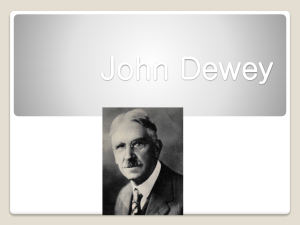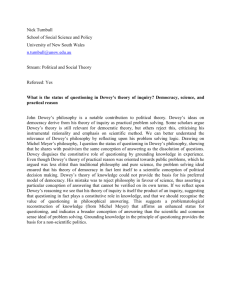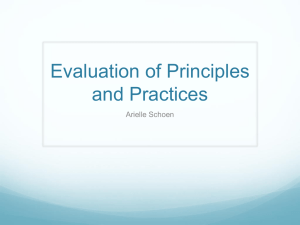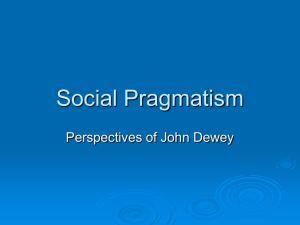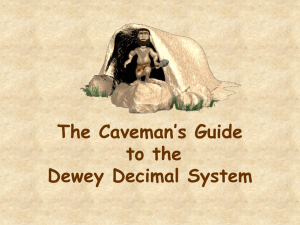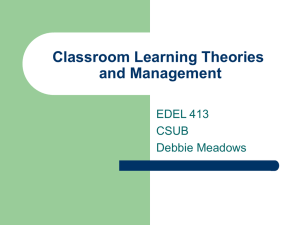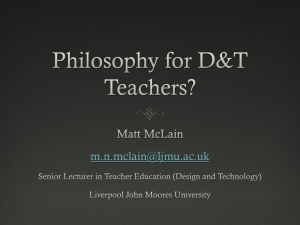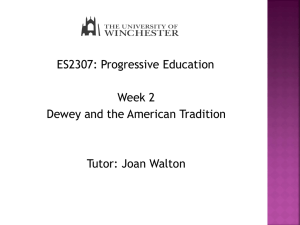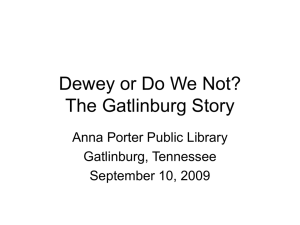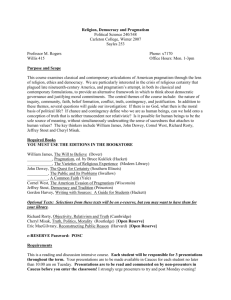CONCEPTUAL ANALYSIS
advertisement
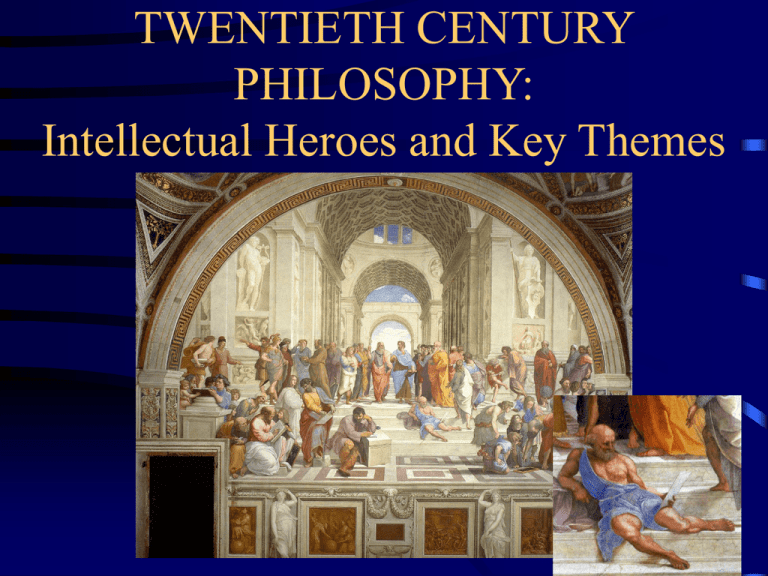
TWENTIETH CENTURY PHILOSOPHY: Intellectual Heroes and Key Themes LECTURES I. II. III. IV. V. VI. The limits of language. Death and authenticity. The great society. Making differences. Social hope. Communicative rationality. THE GREAT SOCIETY 1.REASON AND EXPERIMENT What is pragmatism? 2.SCIENTIFIC RESEARCH AND AESTHETIC EXPERIENCE How to conceive science and art? 3. CITIZENSHIP EDUACTION To what extent are pedagogical ideas and democratic practices related to each other? 1. REASON AND EXPERIMENT JOHN DEWEY BIOGRAPHICAL DATA: 1859: Born October 20, in Burlington (Vermont). 1879: Graduated at the University of Vermont. 1879-1881: Teacher at a secondary school in Oil City (Pennsylvania) and Charlotte (Vermont). 1882-1884: Graduate student at the Johns Hopkins University. 1884: Graduated with a dissertation on the psychology of Kant at the Johns Hopkins University. 1884 – 1894: Professor at the University of Michigan. 1894 - 1904: Professor at the University of Chicago. 1996-1904: Test of pedagogical ideas in the ‘Laboratory School’. 1905 – 1930: Professor at Colombia University. 1918: Visit to Japan and China. 1924: Visit to Turkey. 1926: Visit to Mexico. 1928: Visit to the USSR. 1952: Died June 1, in New York. MAJOR WORKS The School and Society (1900). Democracy and Education (1916). Experience and Nature (1925). The Public and its Problems (1927). The Quest for Certainty (1929). Art as Experience (1934). Logic: The Theory of Inquiry (1938). Freedom and Culture (1939). Problems of Men (1946). THE PRAGMATIC TURN Pragmatism > philosophical movement originated in the United States around 1870. Most important representatives: - Charles Sanders Pierce (1839 - 1914). - William James (1842 - 1910). - John Dewey (1859 - 1952). - George Herbert Mead (1865 – 1931). Central ideas: - clarify concepts, hypotheses and theories by tracing their practical consequences. - fallibilism > look for the rejection of concepts, hypotheses, and theories. Neo-pragmatism: Richard Rorty, Hilary Putnam and Robert Brandom. IDEALISM AND REALISM Before Dewey became a pragmatist he was very much influenced by idealist philosophy (George S. Morris and T.H. Green) and the so-called new liberalism (L.T. Hobhouse). Both they criticize the conception of the individual underlying classical liberalism. The individual is always socially embedded. According to Dewey “men are not isolated non-social atoms, but are men only when in intrinsic relations.’ Freedom is not only a question of being free from external constraints (as classical liberalism states), but also a question of being free to do something. INSTRUMENTALISM Because of the differences between Peirce, James, Mead and Dewey it’s misleading to talk in terms of the school of pragmatism. Dewey calls his version of pragmatism ‘instrumentalism’ that conceives “of both knowledge and practice as means of making goods (…) secure in experienced existence.” Knowledge should be seen as a tool. Mental activities are a function of the adaptation to the social and natural environment. Philosophy should lead to “conclusions which, when they are refereed back to ordinary life-experiences and their predicaments, render them more fruitful.” PHILOSOPHY AS CRITICISM Philosophy should not deliver the means of access to a reality lying behind the everyday life. Philosophy should serve human interests, i.e. it must recover “itself when it ceases to be a device for dealing with the problems of philosophers and becomes a method, cultivated by philosophers, for dealing with the problems of men”. Philosophy is criticism pursued at a high level of self-consciousness and generality. HEURISTIC VALUE Social psychology (George-Herbert Mead amongst others). Philosophical pedagogy (Martha Nussbaum amongst others). Fine Arts (Robert Motherwell amongst others). Neo-pragmatism (Richard Rorty amongst others). Social work (Donald Alan Schön amongst others). Political philosophy (Philipp Dorstewitz amongst others ). Aesthetics (Nelson Goodman amongst others). Sociology (Hans Joas amongst others). 2. SCIENTIFIC RESEARCH AND AESTHETIC EXPERIENCE OVERCOMING THE DESIRE FOR CERTAINTY Epistemology > looking for certain knowledge. It doesn’t make sense to look for a priori knowledge of reality, i.e. knowledge that is cut off from practice. There is not a dichotomy between theoretical judgments and practical judgments. Concepts, hypotheses and theories function as instruments. Inquiry is an activity. Methodology > the normative standards that govern any inquiry, i.e. show how one should proceed. EXPERIMENT Philosophy and science should give weight to the needs of practice. The experiment is the method of science. Concepts, hypotheses and theories should be subject to experiments. Philosophers and scientists are not spectators, but agents who are involved in different practices. Inquiry begins with a problem. All inquiry is the practical concern with the transformation and evaluation of problematic situations. Inquiry aims for “the controlled or directed transformation of an indeterminate situation into one that is so determinate in its constituent distinctions and relations as to convert the elements of the original situation into a unified whole”. ART AND LIFE The philosophy of art that Dewey presents in ‘The Art as Experience’ is anti-idealist and anti-metaphysical. This was attractive for American artists who wanted to get rid of the ‘European’ gap between high and low culture. Artists have to build bridges between the world of art and ordinary life. Dewey inspired many American artists who wanted to establish a new artistic identity. For instance Robert Motherwell. DIFFERENT EXPERIENCES A classical distinction: 1. Common experience. 2. Aesthetic experience. The aesthetic experience should not be privileged, because the roots of it lie in the common experience. The creative work of an artist is not unique. Different is the evocation of immediate enjoyment via the creation of complex objects that directly appeal to the senses. AESTEHTIC EXPERIENCE Dewey argues that the aesthetic experience is mainly a feeling of relief. Good art transcends the conflicts in everyday life; it evokes a sense of harmony. Recipients of art have often the longing to establish the harmony they experience in a context full of conflicts. Artists transform the tensions of everyday life into harmony. Example: Henri Matisse. Beauty is according to Dewey the experience of a harmony that is the result of a struggle with tensions. THE CRITICAL FUNCTION OF ART The art product consist not only of sensible qualities inherent to an object, but also of the meaning that is given to these qualities. Dewey deconstructs two dichotomies: 1. Matter and form. 2. The artist as active creator and the audience as passive recipient of art. As a product of culture art expresses the hopes and ideals of people. Insofar as these hopes and ideals cannot be satisfied in ordinary life, art has a critical function. 3. CITIZENSHIP EDUCATION PROGRESSIVE SOCIAL CHANGE Dewey didn’t plea for a revolution > no revolution, but “intelligent action”, i.e. looking for scientific solutions to social problems. The foundation of a Laboratory School in Chicago was an experiment to solve social problems. Three elements of democracy: 1. Democracy as social inquiry. 2. Democracy as the protection of popular interests. 3. Democracy as the expression of individuality. DEMOCRACY AND EDUCATION Dewey argues that one cannot have a fullfledged democracy without a certain school system. He underlines the importance of two elements of democracy: 1. Schools > educating reasonable citizens. 2. Civil society > the public use of reason. LEARNING BY DOING Dewey distinguishes between an experimental attitude versus a dogmatic attitude. The school is not the place where children learn the unquestioned knowledge that should be memorized. As an extension of the civil society, the school is the place where children discover their interests and explore the world by doing things. Schools give children the opportunity to develop the knowledge and skills they need to become responsible citizens. A SO-CALLED PHANTOM Walter Lippmann: ‘Phantom Public’ (1927). He argues that the presupposition of the classical ideal of the public is not correct. Citizens are not able to understand the complex political world. Thomas Jefferson embodies the classical ideal > every farmer should be able to become president of the United States. Lippmann states that only an elite is able to govern the country. CONTRA AN ELITIST VIEW Dewey criticizes in ‘The Public and its Problems’ the elitist view of Lippmann. Public spheres are the result of active citizens who give expression to a common interest. In the complex Great Society the democratic process isn’t anymore embodied in the local community. Mass media have the responsibility to create a Great Society. PRIVATE AND PUBLIC Underlying problem > expertocracy versus democracy. The public > all those who are (in)directly affected by the consequences of actions. Layman and experts can communicate with each other in order to judge the consequences of actions and have a common interest. The study of the relation between facts and values is important. The mediated public can help to bridge the gap between the face-face-associations of communities and the Great Society. RECOMMENDED 1. John Dewey, The Public and its Problems [translations in several languages]. 2. John Dewey, Democracy and Education [translations in several languages]. 3. Robert. B. Westbrook, John Dewey and American Democracy.
